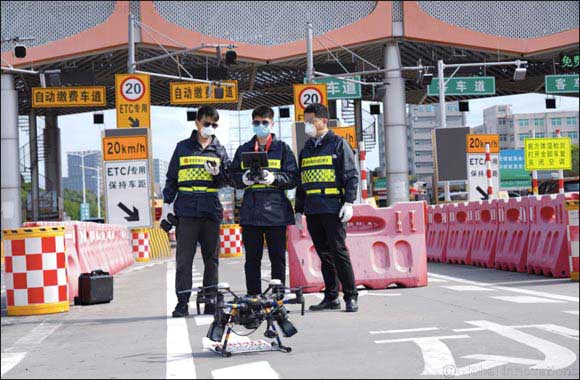Dubai, United Arab Emirates, May 27, 2020: As the world continues to unite in its efforts to combat the spread of COVID-19, government officials are working closely with private sector organizations to adopt new technologies and maintain wellbeing.
DJI and departments across China have deployed drones for known public safety applications and have even discovered new ways drones can be deployed to combat viruses altogether.
As remotely piloted devices, drones are naturally effective at minimizing human interactions, crucial to safeguard communities. DJI’s tests with local partners have had drones deployed in four ways: to facilitate communication, disinfect areas, deliver supplies and measure body temperatures. Some of these applications are new, unique ways to deploy drones, undergoing further testing to measure their effectiveness.
Four ways in which drones are being used to combat the spread of COVID-19:
1. Inspection and Broadcast
In search and rescue missions across the globe – from spanning deserts to towering cliffs – drones have become powerful tools to visualize expansive areas and communicate in complex environments.
These same capabilities have been critical to oversee and communicate in dense, urban areas during the COVID-19 outbreak. With drones, officers can more efficiently scan an area and broadcast a message, such as instructing residents to put their masks on, or to remain indoors – all while keeping officials away from close contact with potentially infected people.
2. Delivery of Critical Supplies
Seeing the risk of a pandemic, local governments have often encouraged citizens to limit their exposure and remain in their homes. This has put strain on package and food delivery systems, which are themselves a potential vector of contamination. While drone package deliveries are not at full scale yet – with only a few prior global tests in countries such as US and the Dominican Republic, they have proven to be an efficient and contactless way to deliver critical medical supplies.
Most drones can be easily modified with a payload drop mechanism to deliver packages of up to 6 KGs, without risk to either party. This is particularly important in areas where the presence of the virus is confirmed, such as hospitals actively treating the virus.
3. Disinfecting Common Areas
While more information about the virus is being discovered and released by officials around the world, there is evidence that the virus may survive on hard surfaces (i.e. chairs, tables), anywhere from just a few hours to several days. This makes public spaces previously occupied by those infected, such as buses, parks, etc., pose a potential risk of infection to others.
In an effort to disinfect public spaces and prevent the further spread of COVID-19, local health authorities have tested out ways to deploy agriculture spraying drones to disinfect these areas more efficiently. Previously used for agriculture, these spraying drones are filled with disinfectants instead of pesticides, and are operated to spray the entire public area.
While the effectiveness of this new disinfection process is yet to be measured in a rigorous way, the speed and area covered in the process is unparalleled. Spraying drones can cover 100,000 m2 in an hour with a spraying tank of 16L.
4. Temperature Check
As the entire country of China has implemented measures to limit the spread of COVID-19, most apartment complexes and other buildings have formed a temperature check process before admitting visitors into the building. This has proven to be a simple, yet effective measure to screen for potentially infected persons, as a key symptom of the virus is a high fever.
While the process has proven effective overall, it has one risk point – the personnel conducting the temperature checks. As they traditionally measure each person with a handheld infrared thermometer, they may come into close contact with the virus and become a spreader themselves.
To limit this one risk point, some teams are using drones equipped with infrared cameras to test temperature measurements. While these drones are commonly used for public safety operations or inspections, with proper calibration, these drones can instead help measure body temperature.
After DJI’s engineering team tested different ways to calibrate airborne infrared cameras to measure body temperature, results showed that by installing a cotton swab within the field of view of the thermal camera, the camera can get an accurate reading. The calibrated drone camera can then be used to measure body temperatures while the officer remains at a safe distance away. While the results are encouraging, it is essential to mention this solution is not designed to be used for standard medical procedures, and to get usable data, the calibration process must follow the procedure strictly.
The Future of Drones in the Healthcare Industry
This is not the first time drones have been implemented in health-related scenarios. In Zanzibar, Tanzania, spraying drones are being deployed to fight Malaria. A group of researchers modified DJI’s Agras platform to spray chemicals onto rice fields to prevent Malaria-carrying mosquitoes from reproducing.
Separately, drones have been used to deliver critical medical supplies or lab samples in areas without the proper infrastructure.
While drones have become commonplace in industries such as construction, film production and public safety, these stories are a signal that drones are likely to become a common tool across the healthcare industry as well, innovating to maintain wellbeing around the world.

